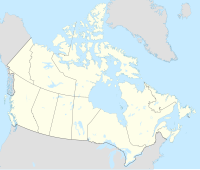|
Duck Lake, Saskatchewan
Duck Lake is a town in the boreal forest of central Saskatchewan, Canada. Its location is 88 kilometres (55 mi) north of Saskatoon and 44 kilometres (27 mi) south of Prince Albert on Highway 11, in the Rural Municipality of Duck Lake No. 463. Immediately to the north of Duck Lake is the south block of the Nisbet Provincial Forest. The First Nations people are Cree and the band government of the Beardy's and Okemasis' Cree Nation is located here. Duck Lake was home to one of the last operating schools in the Canadian Indian residential school system, the St. Michael's Indian Residential School (Duck Lake Indian Residential School), which closed in 1996. HistoryDuck Lake (French: Lac-aux-Canards) was one of the five Southbranch Settlements settled by French-speaking Métis from Manitoba in the 1860s and 1870s. A Roman Catholic Mission was established in Duck Lake in 1874 by Father André O.M.I. and by 1888 the village had a school, a post office (called Stobart), a flour mill (gristmill) and a trading post. From 1882 to 1905 Duck Lake was within the District of Saskatchewan, one of several districts of the Northwest Territories.[5] In 1885, Duck Lake was the site of the Battle of Duck Lake, a conflict between Métis warriors and the Government of Canada, at the start of the North-West Rebellion. At Duck Lake, the Prince Albert Trail, which ran from Regina to Prince Albert, crossed the Carlton Trail and it marked the halfway point between the Métis headquarters at Batoche and the North-West Mounted Police at Fort Carlton.[6]  Historic Carpenter Gothic style All Saints Anglican Church built in 1896 is a municipal heritage site. Its historic cemetery contains the graves of some of those who fought in the Battle of Duck Lake as well as those of other pioneers of the community.[7] The 1973 western Alien Thunder was partially filmed here.[citation needed] DemographicsIn the 2021 Canadian census conducted by Statistics Canada, Duck Lake had a population of 579 living in 202 of its 232 total private dwellings, a change of 1.8 per cent from its 2016 population of 569. With a land area of 2.38 km2 (0.92 sq mi), it had a population density of 243.3/km2 in 2021.[2] Canada census – Duck Lake community profile
Notable people
See alsoReferences
Further reading
External links |
|||||||||||||||||||||||||||||||||||||||||||||||||||||||||||||||||||||||||


